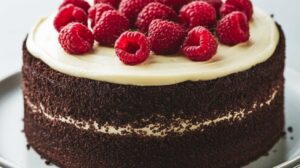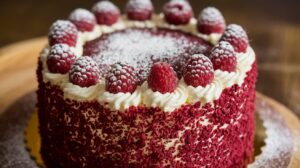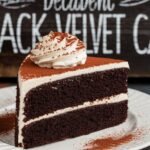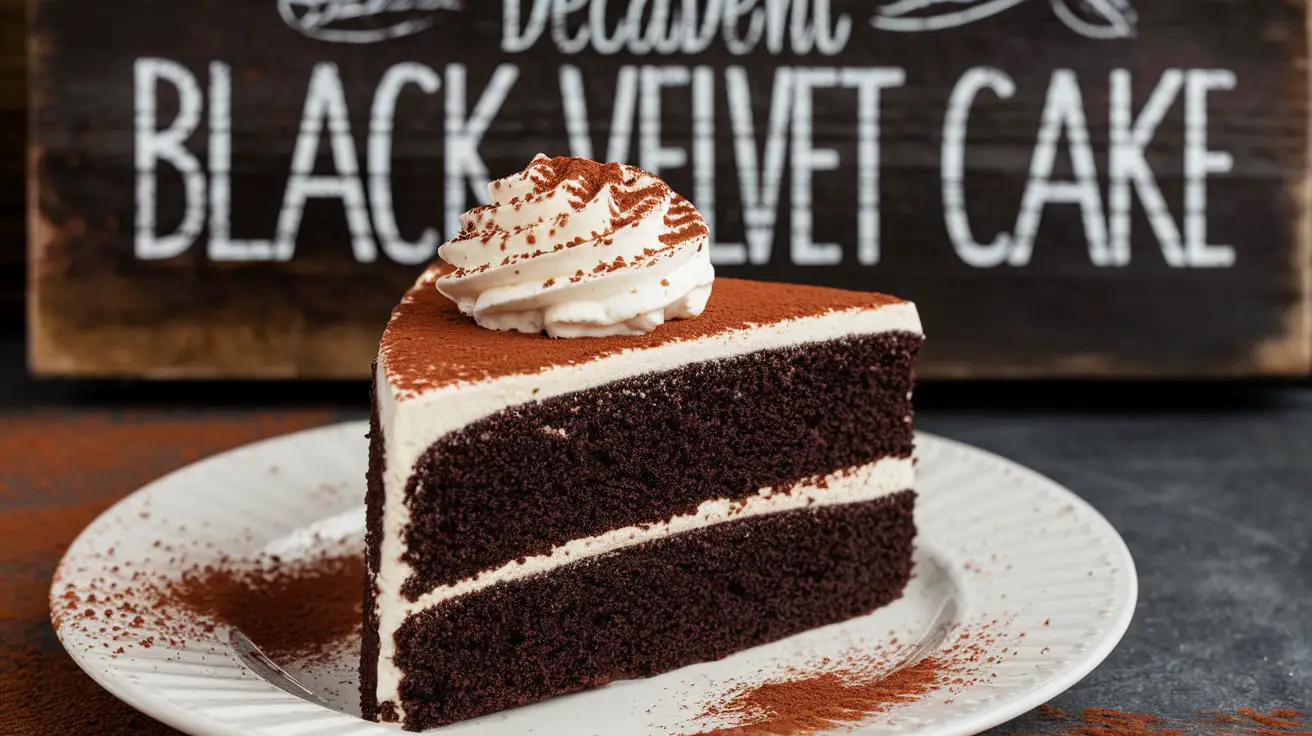When it comes to indulgent desserts, few can rival the allure of a decadent Black Velvet Cake. With its striking dark hue, rich chocolate flavor, and luxurious texture, this cake is a feast for both the eyes and the palate. Whether you’re a seasoned baker or a novice looking for a challenge, mastering the art of Black Velvet Cake is sure to elevate your repertoire.
In this guide, we’ll explore its history, the role of key ingredients, and step-by-step instructions to create your own masterpiece. For an in-depth look at the science behind this dessert, check out The Science of Baking with Cocoa Powder. It explains the nuances of black cocoa powder, the essential ingredient that gives this cake its unique flavor and appearance.
Velvet cakes, including Black Velvet, have a rich history tied to indulgence and celebration. For a historical perspective, The History and Evolution of Velvet Cakes offers insights into their origins and cultural significance.
What is Black Velvet Cake?
Black Velvet Cake is a variation of the classic velvet cake family. Its defining features are its dark, almost black appearance and its velvety texture. Unlike the more familiar Red Velvet Cake, this version relies on black cocoa powder to achieve its signature color and taste. This ingredient, known for its deep flavor and low acidity, transforms a standard chocolate cake into a luxurious dessert.
Why is it Called “Velvet”?
The term “velvet” in cake names refers to the soft, smooth texture achieved by using specific ingredients like buttermilk and cake flour. These components work together to create a crumb that is tender, moist, and irresistibly light.
Ingredients: What Makes It Special?
Creating a perfect Black Velvet Cake starts with understanding its ingredients. Each component plays a crucial role in achieving the cake’s flavor, texture, and appearance.
Key Ingredients
- Black cocoa powder: This ultra-dark, Dutch-processed cocoa powder gives the cake its color and intense chocolate flavor. Regular cocoa powder can’t replicate this effect.
- Buttermilk: Adds a tangy note and ensures a moist, tender crumb.
- Cake flour: Lower in protein than all-purpose flour, it contributes to the cake’s soft texture.
- Unsalted butter: Provides richness and keeps the cake moist.
- Eggs: Act as a binding agent, adding structure to the batter.
- Sugar: Balances the bitterness of cocoa powder with sweetness.
- Baking soda and vinegar: A classic pairing in velvet cakes, this combination reacts to create a fluffy, tender texture.
Optional Enhancements
- Vanilla extract: Adds depth of flavor.
- Espresso powder: Intensifies the chocolate notes.
- Food coloring: While not necessary, some bakers add black food coloring for an even deeper hue.
The History of Velvet Cakes
Velvet cakes have a storied history dating back to the late 19th century. During this period, bakers discovered that combining buttermilk with acidic ingredients like vinegar produced a smoother cake texture. The Red Velvet Cake emerged as a favorite in the Southern United States, with its bright color symbolizing celebration and joy.
The Black Velvet Cake is a modern twist on this classic. It retains the soft texture and rich flavor while presenting a dramatic aesthetic. This cake is particularly popular at weddings, gothic-themed events, and upscale dinner parties.
The Science of Baking with Cocoa Powder
The secret to the decadent Black Velvet Cake lies in its use of black cocoa powder. Unlike natural cocoa powder, black cocoa is heavily alkalized, which reduces its acidity and deepens its flavor. This alkalization process also darkens the cocoa, giving the cake its almost jet-black appearance.
In baking, the balance of acids and bases is crucial for achieving the desired texture and rise. Ingredients like buttermilk and vinegar ensure that even with the low acidity of black cocoa, the cake rises perfectly and remains moist.
To understand more about how black cocoa works, visit The Science of Baking with Cocoa Powder.
Step-by-Step Recipe for Black Velvet Cake

Ingredients
- Dry Ingredients:
- 1 ¾ cups cake flour
- 1 cup black cocoa powder
- 1 ½ cups granulated sugar
- ½ tsp salt
- Wet Ingredients:
- 1 cup buttermilk
- ½ cup unsalted butter, softened
- 2 large eggs
- 1 tsp vanilla extract
- 1 tsp vinegar
- 1 tsp baking soda
Instructions
- Prepare the pans: Grease two 8-inch cake pans and line them with parchment paper.
- Preheat the oven: Set it to 350°F (175°C).
- Mix dry ingredients: In a medium bowl, sift together cake flour, black cocoa powder, and salt.
- Cream butter and sugar: In a large bowl, beat butter and sugar until light and fluffy. Add eggs one at a time, mixing well after each addition. Stir in vanilla extract.
- Combine wet and dry ingredients: Gradually add the dry mixture to the creamed butter mixture, alternating with buttermilk.
- Activate the leavening agents: In a small bowl, combine vinegar and baking soda. Stir it into the batter quickly and evenly.
- Bake: Divide the batter evenly between the prepared pans. Bake for 25-30 minutes or until a toothpick inserted into the center comes out clean.
- Cool and frost: Allow the cakes to cool completely before frosting with your choice of topping.
Frosting and Decoration Ideas
Frosting Options
- Cream Cheese Frosting: The tanginess pairs beautifully with the richness of the cake.
- Chocolate Ganache: A shiny, smooth topping for a luxurious finish.
- Espresso Buttercream: Enhances the chocolate flavor with a subtle coffee note.
Decorating Tips
- A decadent Black Velvet Cake is a visual masterpiece as much as it is a delicious treat. The rich, dark hue of the cake provides a stunning base for creative decoration, making it a showstopper for any occasion. Here are some tips and ideas to elevate your cake presentation:
1. Frosting Techniques
The choice of frosting and how you apply it can dramatically change the cake’s appearance.
Smooth Finish
- Use a bench scraper or offset spatula to create a clean, polished surface with buttercream or ganache.
- For a super-smooth finish, chill the frosted cake for 20 minutes and apply a second thin layer to cover imperfections.
Textured Frosting
- Create rustic waves using the back of a spoon or spatula.
- Use piping tips for elegant rosettes, ruffles, or borders around the edges.
2. Add Metallic Accents
- Gold or silver leaf: Edible metallic sheets can be applied strategically to create a luxurious effect.
- Metallic drips: Use a piping bag to add drips of gold- or silver-tinted ganache along the edges.
3. Incorporate Fresh Elements
- Berries: Fresh raspberries, blackberries, or blueberries add vibrant pops of color against the dark cake.
- Edible flowers: Use options like pansies, marigolds, or violets to create a romantic and natural look.
- Herbs: A sprig of rosemary or mint can add a fresh and sophisticated touch.
4. Chocolate Decorations
- Shards: Spread melted chocolate on parchment paper, let it harden, and break it into shards for an edgy, modern design.
- Curls: Use a vegetable peeler to shave chocolate into delicate curls for a classic finish.
- Drizzle: Create artistic drips by drizzling melted white or dark chocolate over the frosting.
5. Powdered Sugar and Stencils
- Lay a stencil over the top of the cake and dust with powdered sugar or cocoa powder to create intricate patterns.
- Use stencils to make themes or designs that match the event, such as hearts, stars, or lace patterns.
6. Creative Cake Toppers
- Custom toppers: Add a personalized cake topper with names, monograms, or occasion-related text.
- Edible toppers: Use fondant or gum paste to craft shapes like flowers, bows, or abstract sculptures.
- Minimalist candles: Opt for simple, sleek candles to complement the cake’s elegance.
7. Contrast with Colors
- Pair the deep black cake with white or light-colored frosting for a dramatic contrast.
- Use vibrant accents like red (berries or flowers) or gold for a bold, eye-catching finish.
8. Themed Decorations
Adapt the cake for special occasions with these ideas:
- Gothic theme: Use dark red roses, black fondant details, and a glossy black mirror glaze.
- Wedding elegance: Add edible pearls, lace piping, and subtle floral arrangements.
- Holiday fun: Use green and red accents for Christmas or orange and purple for Halloween.
Common Challenges and Solutions

Baking the perfect Black Velvet Cake can be tricky, especially if you’re new to working with black cocoa powder or creating a velvet-textured cake. Below are some common issues and practical solutions to ensure your cake turns out flawless every time.
1. Dry Cake
Cause:
- Using too much flour or not enough liquid.
- Overbaking the cake.
Solution:
- Measure flour accurately by using the spoon-and-level method. Avoid scooping flour directly from the bag, as it can compact and result in excess flour.
- Set a timer and check for doneness 2-3 minutes before the recommended baking time. A toothpick inserted into the center should come out with a few moist crumbs, not completely clean.
2. Sinking Center
Cause:
- Overmixing the batter, which incorporates too much air.
- Opening the oven door during baking, causing a sudden temperature drop.
- Incorrect leavening agent ratios.
Solution:
- Mix the batter only until the ingredients are just combined. Avoid vigorous stirring after adding the wet and dry ingredients together.
- Keep the oven door closed until at least 75% of the baking time has elapsed.
- Ensure accurate measurements of baking soda and vinegar, as they provide the rise necessary for the cake’s structure.
3. Crumbly Texture
Cause:
- Using all-purpose flour instead of cake flour.
- Not enough binding agents like eggs or butter.
Solution:
- Always use cake flour for a finer crumb. If unavailable, make a substitute by replacing 2 tablespoons of every 1 cup of all-purpose flour with cornstarch.
- Follow the recipe’s ratios for eggs and butter precisely, as they are essential for the cake’s structure.
4. Bitter Flavor
Cause:
- Overusing black cocoa powder without balancing the bitterness with sugar or other ingredients.
Solution:
- Stick to the recipe’s specified amount of cocoa powder. If you prefer a more intense chocolate flavor, consider adding a touch of espresso powder to deepen the taste rather than increasing the cocoa.
5. Dense or Heavy Cake
Cause:
- Using cold ingredients, which prevent proper aeration.
- Not creaming butter and sugar thoroughly.
Solution:
- Bring all ingredients to room temperature before starting. Cold butter, eggs, and buttermilk can hinder the batter’s ability to aerate.
- Beat butter and sugar together until the mixture becomes light and fluffy. This process is essential for creating the air pockets that give the cake its light texture.
6. Cake Sticking to the Pan
Cause:
- Not properly preparing the pans.
Solution:
- Grease the pans with butter or a non-stick spray and line the bottoms with parchment paper. The parchment ensures the cake releases easily, even if the edges stick slightly.
7. Uneven Layers
Cause:
- Batter not evenly distributed in the pans.
- Oven racks not level.
Solution:
- Use a kitchen scale to divide the batter evenly between pans for consistent layer sizes.
- Check your oven racks with a spirit level to ensure they’re perfectly flat.
FAQs About Black Velvet Cake
1. What is the difference between Black Velvet Cake and Red Velvet Cake?
The primary difference lies in the use of black cocoa powder in Black Velvet Cake, which gives it a darker color and richer flavor.
2. Can I use regular cocoa powder instead of black cocoa powder?
Yes, but the cake will have a milder flavor and lighter color.
3. Is Black Velvet Cake suitable for vegans?
With substitutions like plant-based butter and flax eggs, the recipe can be made vegan.
4. How should I store Black Velvet Cake?
Store it in an airtight container at room temperature for up to 3 days, or refrigerate for up to a week.
5. What occasions is Black Velvet Cake ideal for?
This cake is perfect for weddings, gothic-themed events, and any occasion that calls for a dramatic and elegant dessert.
Print
Decadent Black Velvet Cake
Description
Discover the ultimate recipe for a decadent Black Velvet Cake. Learn to bake and decorate this rich, elegant dessert like a pro
Ingredients
- Dry Ingredients:
- 1 ¾ cups cake flour
- 1 cup black cocoa powder
- 1 ½ cups granulated sugar
- ½ tsp salt
- Wet Ingredients:
- 1 cup buttermilk
- ½ cup unsalted butter, softened
- 2 large eggs
- 1 tsp vanilla extract
- 1 tsp vinegar
- 1 tsp baking soda
Instructions
Frosting Options
- Cream Cheese Frosting: The tanginess pairs beautifully with the richness of the cake.
- Chocolate Ganache: A shiny, smooth topping for a luxurious finish.
- Espresso Buttercream: Enhances the chocolate flavor with a subtle coffee note.
Decorating Tips
- Add edible gold leaf for a touch of opulence.
- Garnish with fresh berries or chocolate shavings for color contrast.
- Pipe intricate designs using a piping bag and nozzle.
For expert decorating techniques, check out Tips for Perfect Cake Decoration.

